Ontario Premier Advocates for Tough Tariffs on Chinese Electric Vehicles
Ontario Premier Doug Ford is urging the federal government to impose significant tariffs on Chinese-made electric vehicles.
“By taking advantage of low labor standards and unsustainable energy practices, China is saturating the market with artificially inexpensive electric vehicles. Without prompt action, we jeopardize jobs in Ontario and Canada,” stated Mr. Ford.
Mr. Ford highlighted the billions in taxpayer subsidies allocated for electric vehicle and battery manufacturing in Canada.
“Ontario has secured $43 billion in investments for electric vehicle and battery manufacturing, safeguarding hundreds of thousands of quality, well-paying jobs. This accomplishment was a collective effort involving the federal government and our private sector partners,” the statement emphasized.
Mr. Ford urged Ottawa to safeguard the industry’s supply chains in the U.S. and Canada.
“Now is the time to protect hard-earned Ontario and Canadian jobs by aligning with U.S. tariffs on Chinese imports,” emphasized the premier.
Prime Minister Justin Trudeau, when questioned about the issue by reporters on the same day, did not commit to the request.
“We are closely monitoring the actions taken by the Americans and our other allies. Last week, during my meeting with other G7 leaders in Italy, we discussed this extensively,” stated Mr. Trudeau at an event in Westville, Nova Scotia.
“Rest assured, we will continue to support Canadian workers and industries. We will carefully consider the necessary steps to ensure ongoing support for the Canadian auto industry and consumers,” the prime minister assured.
Mr. Ford’s statement coincided with remarks from the federal minister of energy and natural resources, who expressed hope for scaling back subsidies for EV purchases.
In response to inquiries from reporters, Jonathan Wilkinson affirmed his backing for EV purchase subsidies, despite the trend of higher-income individuals buying EVs.
“When introducing new technologies that require adoption, early adopters are crucial to kickstart the process. Typically, early adopters are tech-savvy individuals interested in new advancements, often residing in higher-income areas,” expressed Mr. Wilkinson. “Their role is vital in catalyzing the market to drive down costs, rendering long-term subsidies unnecessary.”
These subsidies are supplemented by provincial rebates, which vary by province. For example, British Columbia provides rebates of up to $4,000 for fully electric vehicles, while Nova Scotia offers up to $3,000. In contrast, Alberta and Saskatchewan do not offer any rebates.
“Eventually, subsidies for electric vehicles will no longer be necessary once production scales up, reducing costs to compete fully with internal combustion engines,” forecasted Mr. Wilkinson.
Seamus O’Regan, the federal labor minister, highlighted barriers to EV sales, such as inadequate charging infrastructure across the country.
“As infrastructure expands and prices decrease, consumer preferences will shift, right?” Mr. O’Regan asked reporters. “The truth is, electric vehicles offer an exceptional driving experience.”
Beyond the subsidy debate looms the issue of critical minerals like copper.
The report underscored the three to fivefold increase in copper demand for EVs, compared to conventional vehicles. Additionally, the power grid necessitates significant upgrades, demanding additional copper to facilitate the transition.
“A regular Honda Accord requires about 40 pounds of copper. Conversely, an electric Honda Accord demands nearly 200 pounds of copper,” noted Adam Simon, one of the study’s authors and a professor of earth and environmental studies.
“Onshore wind turbines use approximately ten tons of copper, which doubles in offshore installations. Our analysis shows that mining companies may struggle to meet the escalating copper demand,” he added.
The study proposed emphasizing the production of hybrid vehicles as they require less copper than EVs while still reducing emissions.






